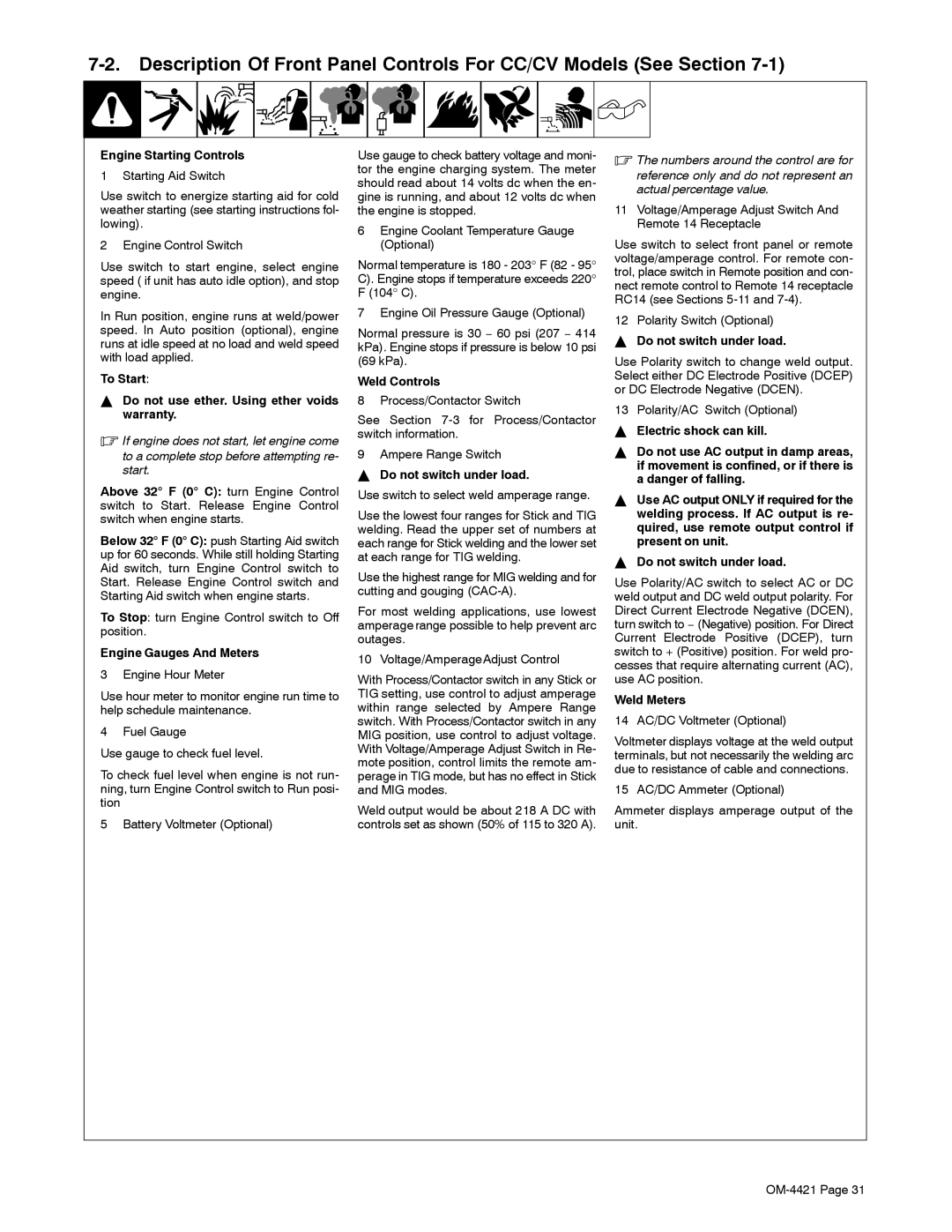Processes
OM-4421215 075N
Description
File Engine Drive
From Miller to You
Table of Contents
− Maintenance & Troubleshooting
Standards
Directives
Decrot9/06
Decrotsound6/05
Manufacturer European Contact Notified Body
Arc Welding Hazards
Symbol Usage
Engine Hazards
Compressed Air Hazards
California Proposition 65 Warnings
Principal Safety Standards
EMF Information
Radiation can cause interference
− Consignes DE Sécurité − Lire Avant Utilisation
Signification des symboles
UN Choc Électrique peut tuer
LES Fumées ET LES GAZ peuvent être dangereux
DES Particules Volantes peuvent blesser les yeux
LE Soudage peut provoquer un in- cendie ou une explosion
DES Pièces Chaudes peuvent provoquer des brûlures graves
LE Bruit peut affecter l’ouïe
’EMPLOI Excessif peut
’AIR Comprimé peut provoquer des blessures
LE Surchauffement peut endom- mager le moteur électrique
LES Étincelles Volantes risquent de provoquer des blessures
Pour les moteurs à essence
LE Soudage À L’ARC risque de provoquer des interférences
Pour les moteurs diesel
Boulevard, Rexdale, Ontario, Canada M9W 1R3 téléphone
− 50 h Std
− Definitions
Std
CC Models CC/CV Models CC Export Models
Manufacturer’s Rating Labels
OM-4421
Symbols And Definitions
Weld, Power, And Engine Specifications
− Specifications
Dimensions, Weights, And Operating Angles
Volt-Ampere Curves For CC Models
MIG Mode
Stick Mode
TIG Mode
Volt-Ampere Curves For CC/CV Models
Exceeding duty cycle can damage unit and void warranty
Curve shows typical fuel use under weld or power loads
Fuel Consumption
Duty Cycle And Overheating
Optional Three-Phase Generator Curves
AC Generator Power Curve
12 kVA/kW Single-Phase AC Output No Weld Load
15 kVA/kW Three-Phase AC Output No Weld Load
Installing Welding Generator
− Installation
Location/Airflow Clearance
Grounding1
Using Lifting Eye
Supporting The Unit
Mounting Welding Generator
Mounting Surface
To Bolt Unit In Place
Tools Needed 1/2
Installing Exhaust Pipe
Stop engine and let cool
Connecting The Battery
Activating The Dry Charge Battery If Applicable
Do not overfill battery cells
For 30 Minutes
Engine Prestart Checks
Coolant Recovery Tank
Full Capacity Engine 9.5 qt 9.01L Diesel
Hot Full Cold Full
Stick and TIG Welding
Connecting To Weld Output Terminals
MIG and Fcaw Welding
Stop engine
150 ft 200 ft 250 ft
Selecting Weld Cable Sizes
350 ft 400 ft 45 m 60 m 70 m 90 m 105 m 120 m
Stop engine before
Socket
Connecting To Remote 14 Receptacle RC14 On CC/CV Models
Front Panel Controls For CC Models See Section
− Operating Welding Generator − CC Models
Do not switch under load
To Start Do not use ether. Using ether voids warranty
Engine Starting Controls
Engine Gauges And Meters
Weld Control/Arc Condition Information Label
Remote Amperage Control On CC Models Optional
Example Combination Remote Amperage Control Stick
OM-4421
Front Panel Controls For CC/CV Models See Section
− Operating Welding Generator − CC/CV Models
Voltage/Amperage Adjust Switch And Remote 14 Receptacle
Use switch to select weld amperage range
14 AC/DC Voltmeter Optional
Process/Contactor Switch Settings
Process/Contactor Switch On CC/CV Models
Example Combination Remote Amperage Control TIG
Remote Voltage/Amperage Control On CC/CV Models Optional
Volt And 240 Volt Receptacles
− Operating Auxiliary Equipment
Rear Of Panel
Single-Phase Generator Power Three-Phase Power Connection
Close panel opening if no connections are made to generator
240 V 15 a AC South African Receptacle RC1
Optional Generator Power Receptacles
Supplementary Protector CB2 Supplementary Protector CB3
Maintenance Label
− Maintenance & Troubleshooting
Routine Maintenance
Checking Generator Brushes
By the warranty
Servicing Air Cleaner
To clean air filter
Do not clean housing with air hose
Stop engine and let cool. Reinstall cleanout plug
Inspecting And Cleaning Optional Spark Arrestor Muffler
Tools Needed 3/8
Weld/Power Speed Adjustment
Adjusting Engine Speed
Engine Speed No Load
Standard Model Idle Speed Ad- justment
Servicing Fuel And Lubrication Systems
Overload Protection
Welding − CC Models
Troubleshooting
Welding − CC/CV Models
Optional Three-Phase Generator Power CC/CV Models Only
Standard Generator Power
Engine
OM-4421
Circuit Diagram For CC Welding Generator
− Electrical Diagrams
223 522-B
Circuit Diagram For CC/CV Welding Generator
223 523-B
Wetstacking
− RUN-IN Procedure
Welding Generator
Procedure at less than
Run-In Procedure Using Load Bank
Stop engine Do not touch hot exhaust
From flammables Do not Perform
Bank/grid
Run-In Procedure Using Resistance Grid
From flammables
Do not perform run-in
Selecting Equipment
− Generator Power Guidelines
Grounding Generator To Truck Or Trailer Frame
How Much Power Does Equipment Require?
Grounding When Supplying Building Systems
Earth ground if supplying
Amperes x Volts = Watts
Approximate Power Requirements For Farm/Home Equipment
Approximate Power Requirements For Industrial Motors
Industrial Motors Rating Starting Watts Running Watts
Farm/Home Equipment Rating Starting Watts Running Watts
Contractor Rating Starting Watts Running Watts
Approximate Power Requirements For Contractor Equipment
How Much Power Can Generator Supply?
Power Required To Start Motor
Single-Phase Induction Motor Starting Requirements
KVA/HP x HP x 1000 = Starting Amperage
Typical Connections To Supply Standby Power
Current Load Watts Amperes
Selecting Extension Cord Use Shortest Cord Possible
− Parts List
93 −6 105 104 100 101 102 103
Main Assembly
010
Figures 13-2
Figures 13-4
Control Box Assembly − CC Models
087
Control Box Assembly − CC/CV Models -1Item
Control Box Assembly − CC/CV Models
TD1 214
3634
Panel, Front w/Components − CC Models
Panel, Front w/Components − CC Models -1Item
40 39
Panel, Front w/Components − CC/CV Models
Panel, Front w/Components − CC/CV Models -1Item
170
Generator -1Item
Generator
602 SCREW, .312−18x .75 hexwhd.66d stl pld slffmg tap−rw 601
Main Rectifier Assembly
Wiring Harnesses
PLG4
Harness, receptacle auxiliary power export models includes
Page
Your distributor also gives
Service
Support
Miller Electric Mfg. Co
To locate a Distributor or Service Agency visit
For assistance in filing or settling claims, contact
Your distributor and/or equipment manufacturer’s

